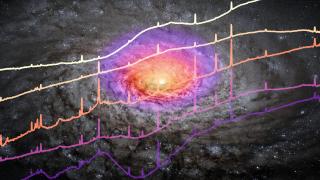Bibcode
Lopez-Rodriguez, E.; Packham, C.; Jones, T. J.; Siebenmorgen, R.; Roche, P. F.; Levenson, N. A.; Alonso-Herrero, A.; Perlman, E.; Ichikawa, K.; Ramos Almeida, C.; González-Martín, O.; Nikutta, R.; Martinez-Paredez, M.; Shenoy, D.; Gordon, M. S.; Telesco, C. M.
Bibliographical reference
Monthly Notices of the Royal Astronomical Society, vol. 464, issue 2, pp. 1762-1770
Advertised on:
1
2017
Citations
11
Refereed citations
11
Description
We present high-angular (0.17$-$0.35 arcsec) resolution imaging
polarimetric observations of Mrk 231 in the 3.1 $\mu$m filter using
MMT-Pol on the 6.5-m MMT, and in the 8.7 $\mu$m, 10.3 $\mu$m, and 11.6
$\mu$m filters using CanariCam on the 10.4-m Gran Telescopio CANARIAS.
In combination with already published observations, we compile the
1$-$12 $\mu$m total and polarized nuclear spectral energy distribution
(SED). The total flux SED in the central 400 pc is explained as the
combination of 1) a hot (731 $\pm$ 4 K) dusty structure, directly
irradiated by the central engine, which is at 1.6 $\pm$ 0.1 pc away and
attributed to be in the pc-scale polar region, 2) an optically-thick,
smooth and disk-like dusty structure (`torus') with an inclination of 48
$\pm$ 23$^{\circ}$ surrounding the central engine, and 3) an
extinguished (A$_{\mbox{V}} =$ 36 $\pm$ 5 mag) starburst component. The
polarized SED decreases from 0.77 $\pm$ 0.14 per cent at 1.2 $\mu$m to
0.31 $\pm$ 0.15 per cent at 11.6 $\mu$m and follows a power-law
function, $\lambda^{\sim0.57}$. The polarization angle remains constant
($\sim$108$^{\circ}$) in the 1$-$12 $\mu$m wavelength range. The
dominant polarization mechanism is explained as scattering off hot dust
grains in the pc-scale polar regions.
Related projects

Nuclear Activity in Galaxies: a 3D Perspective from the Nucleus to the Outskirts
This project consists of two main research lines. First, the study of quasar-driven outflows in luminous and nearby obscured active galactic nuclei (AGN) and the impact that they have on their massive host galaxies (AGN feedback). To do so, we have been granted time with the Gran Telescopio CANARIAS (GTC) in the optical and near-infrared ranges
Cristina
Ramos Almeida